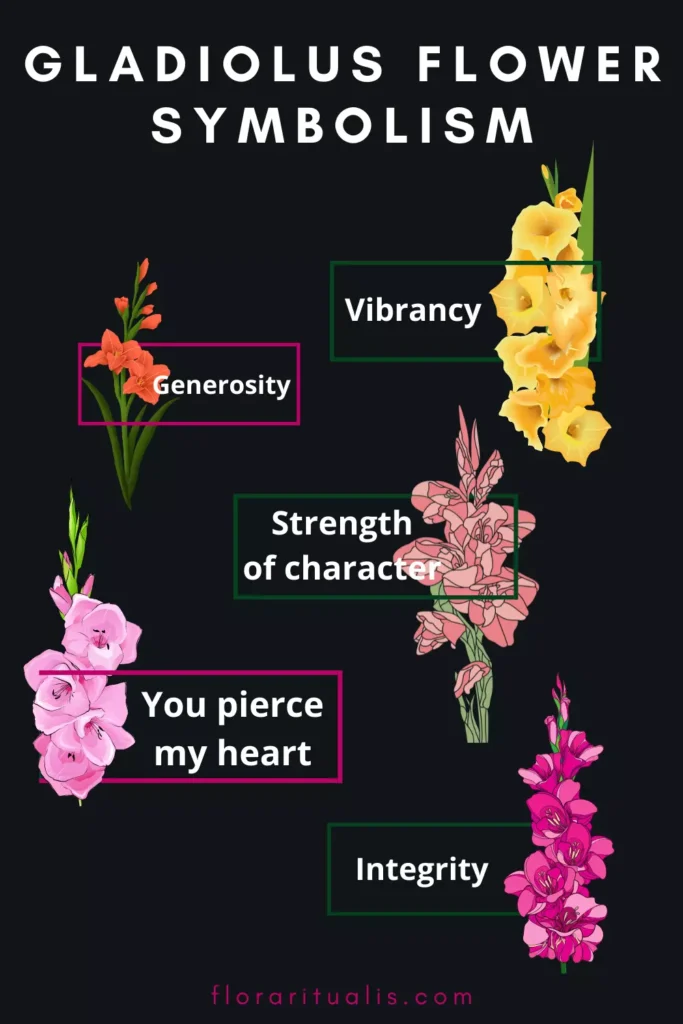The gladiolus flower also known as sword lily, corn-flag or sword-flag. The gladiolus flower meaning stems from its various myths and symbolism.
In this blog we will explore why the gladiolus flower is a perfect birth flower for august.
We will also explore the migration history of this flower, the various myths that surround the flower, the symbolism of the flower and when to gift this flower.
What does the gladiolus flower signify?
The gladiolus flower signifies generosity, love at first sight, moral integrity, strength and vibrancy. The flower falls under the dominion of the Sun and reflects the qualities of the zodiac Leo.
The Origins
The Gladiolus flower belong to the family of Iris. It is native to Europe, South Africa, Asia, and South America.
The Ancient Greeks were potentially the ones to propagate the plant from South Africa.
In Europe around the 19th century, there was a boom in gladiolus production. During this period specifically in England various hybrids were produced for the first time which were later commercialised.
This began to spread across various parts of Europe such as France and Germany, then later to the United States and India.
Gladiolus flower through myths
In classical Greek mythology, the gladiolus flower meaning links to the god Apollo.
The story revolves around Hyacinthus who was accidentally killed by the discus of the god Apollo and a gladiolus flower sprouted from his corpse.
Another myth surrounding the flower was about Ceres or Demeter the goddess of harvest. She had a sacred grove from which an irreligious man would repeatedly steal firewood.
One day the man beheaded one of Demeter’s worshipers and from the disciple’s blood sprouted a gladiola.
The man became poor and he tried to sell his daughter, fortunately she managed to escape from him. Demeter found her in the grove and turned her into a gladiola.

Gladiolus flower through symbolism
The botanical name for the gladiolus flower is gladiola. Gladiola translates to little sword this derives from the Latin word gladius which translates to “sword”.
This is possibly due to the gladiola leaves whose shape are like a sword. As a result of the flower’s association with weaponry, the flower came to symbolise strength of character.
Uses of Gladiolus flower with symbols
- Leaves of gladiolus acts as protection spells because its shape like swords. The leaves can be tied together and facing down.
- The leaves of gladiolus also aids to dispel any spirits by placing a bundle over the bed.
- Dreaming about the gladiolus is a message from your angels, spirit guides or from loved ones who have died.
- It aids in treating digestive issues and raise energy levels.
- The corm (flowering bulb) of the gladiolus can help to alleviate painful menstruation and rheumatism.
- Old herbalists have recorded that the upper root of the gladiolus provokes lustful passions, which the lower root of the plant causes barrenness.
Gifting Gladiolus flowers
Since the gladiolus flower meaning is associated with the god Apollo who is the sun god it makes it intimately associated to the month of August.
The Gladiolus flower is a birth flower for those born in August. The flower stands for strength of character, victory, vigor, bravery and remembrance.
Gladiolus is the flower of Friendship Day, which is the first Sunday is August.
August also kicks off the harvest festival which pays tribute to the goddess Demeter or Ceres as a symbol of fertility and harvest.
If you liked our blog on the Gladiolus flower then make sure to read our other blogs of flowers and plants under the dominion of the sun.
FAQs Gladiolus Flower
Resources
Cumo, C. (Ed.). (2013). Encyclopedia of Cultivated Plants [3 volumes]: From Acacia to Zinnia. ABC-CLIO.
Dietz, S. T. (2022). The complete language of flowers the complete language of flowers: A definitive and illustrated history – pocket edition. Wellfleet Press.
Watts, D., & Watts, D. C. (2007). Dictionary of Plant Lore. Academic Press.
Deena Bsingh, a UK-born, Mauritius-raised content writer, is a dedicated explorer of the ancient world’s hidden treasures. Armed with classical studies knowledge and a decade of spiritual immersion, Deena delves deep into the wellspring of ancient wisdom. Her illuminating writings on flower meanings and culinary history are imbued with the profound insights she has gathered on her journey. Through her Medium articles, she guides readers on transformative journeys that bridge the gap between ancient cultures and contemporary consciousness, offering a rich tapestry of understanding that endures through time.

